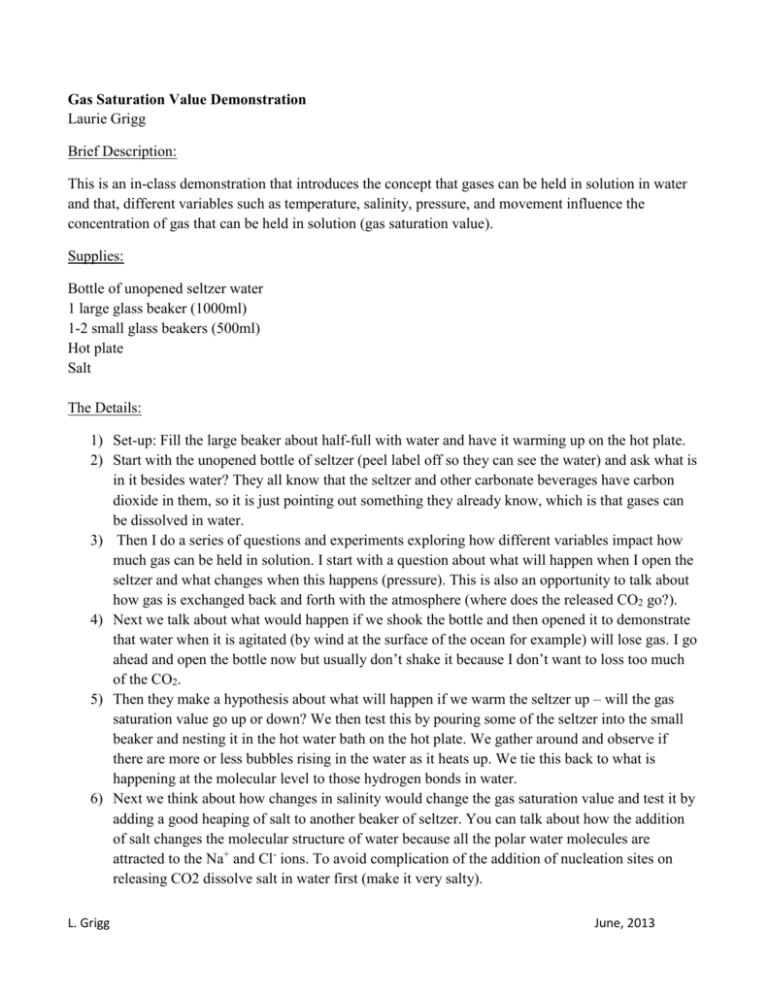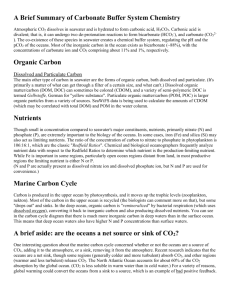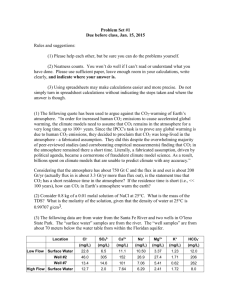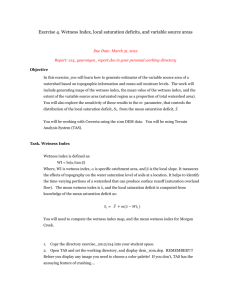Gas Saturation Value Demonstration
advertisement

Gas Saturation Value Demonstration Laurie Grigg Brief Description: This is an in-class demonstration that introduces the concept that gases can be held in solution in water and that, different variables such as temperature, salinity, pressure, and movement influence the concentration of gas that can be held in solution (gas saturation value). Supplies: Bottle of unopened seltzer water 1 large glass beaker (1000ml) 1-2 small glass beakers (500ml) Hot plate Salt The Details: 1) Set-up: Fill the large beaker about half-full with water and have it warming up on the hot plate. 2) Start with the unopened bottle of seltzer (peel label off so they can see the water) and ask what is in it besides water? They all know that the seltzer and other carbonate beverages have carbon dioxide in them, so it is just pointing out something they already know, which is that gases can be dissolved in water. 3) Then I do a series of questions and experiments exploring how different variables impact how much gas can be held in solution. I start with a question about what will happen when I open the seltzer and what changes when this happens (pressure). This is also an opportunity to talk about how gas is exchanged back and forth with the atmosphere (where does the released CO2 go?). 4) Next we talk about what would happen if we shook the bottle and then opened it to demonstrate that water when it is agitated (by wind at the surface of the ocean for example) will lose gas. I go ahead and open the bottle now but usually don’t shake it because I don’t want to loss too much of the CO2. 5) Then they make a hypothesis about what will happen if we warm the seltzer up – will the gas saturation value go up or down? We then test this by pouring some of the seltzer into the small beaker and nesting it in the hot water bath on the hot plate. We gather around and observe if there are more or less bubbles rising in the water as it heats up. We tie this back to what is happening at the molecular level to those hydrogen bonds in water. 6) Next we think about how changes in salinity would change the gas saturation value and test it by adding a good heaping of salt to another beaker of seltzer. You can talk about how the addition of salt changes the molecular structure of water because all the polar water molecules are attracted to the Na+ and Cl- ions. To avoid complication of the addition of nucleation sites on releasing CO2 dissolve salt in water first (make it very salty). L. Grigg June, 2013 7) Then we make a list on the board of all the variables we just tested (pressure, movement or agitation, temperature, and salinity) and their relative influence on the gas saturation value of water. 8) Finally you can follow-up with some real-life ocean questions. Here are a few examples: Which of the following surface waters would you expect to have the highest gas saturation value and why? A. Surface waters off Key West. Florida B. Surface water during the winter in the Arctic Ocean C. Water from the bottom of the Java Trench D. Water from the bottom of Sunset Lake (temperate lake with inverse thermal stratification that we study for lab) in the winter The correct answer is C because A is warm, B is salty from the formation of sea-ice, and D is cold but not as cold or deep as the bottom of a trench. How does this help explain why coral reefs are mostly found in shallow, subtropical water? Shallow, subtropical waters are warm and salty (high evaporation rates) and thus have a low gas saturation value. This means the water can hold less CO2 which increases the pH and allows corals to produce CaCO3. How will the warming of the ocean impact the gas saturation value of the ocean? Warmer oceans will lower the gas saturation value. (This question can lead to several more considering the positive and negative feedbacks on CO2 concentration in both the ocean and the atmosphere.) For the atmosphere this is positive feedback because it means the oceans will be capable of absorbing less CO2 from the atmosphere which is the ultimate cause of the warming. For the oceans it is a negative feedback to the increased absorption of CO2 from the atmosphere and will help decrease the amount of CO2 the oceans can absorb. L. Grigg June, 2013








